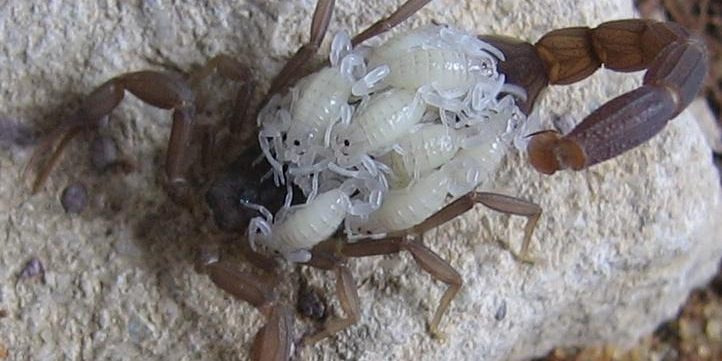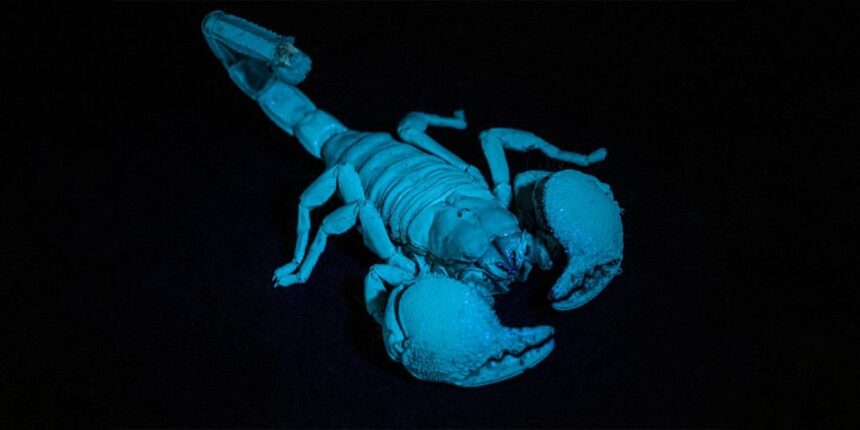Scorpions Can Detach Their Tails, But They Die from Constipation
If you ask anyone which animal drops its tail to distract a predator, the answer would most likely be: “A lizard!” Not all lizards can do this, but many indeed use this tactic to escape.
However, lizards don’t have a monopoly on this ability. Scorpions can also sacrifice their tails to survive.
When a predator grabs a Ananteris balzani scorpion by the tail, the scorpion easily discards it and flees. But this doesn’t bring happiness to the scorpion. The problem is that the anus of this arachnid is located next to its stinger, and with its tail gone, the scorpion cannot defecate.
Therefore, a tailless scorpion urgently seeks out a female to mate with, trying to leave behind some memory of itself before it dies from constipation.
Its chances are low, but its determination sharply increases.
Scorpions Glow Under Ultraviolet Light
If you look at a scorpion under an ultraviolet lamp—or in the moonlight—it will glow bright blue-green. Scientists are still unsure why this happens, but there are three plausible reasons.
Firstly, the glow might help arachnids find mates in the dark.
These creatures are active at dusk and at night, and the ability to quickly identify others of their kind in low light is quite useful.
Secondly, substances produced by the scorpion’s outer shell reflect ultraviolet light and could act as a kind of sunscreen.
This can be helpful when living in a hot climate.
Lastly, phthalic acid ether, a component of the scorpion’s fluorescent compounds, offers excellent protection against fungi and parasites.
Scorpions Once Lived in Oceans and Grew Up to Three Meters Long
Modern scorpions are not impressive in size—the largest, the emperor scorpion, can reach a length of only 20–23 cm.
But the ancestors of these modern critters were much more formidable. Eurypterids, also known as sea scorpions, lived during the Paleozoic era (from 467 to 248 million years ago) and grew up to 2–3 meters long. They fed on fish and smaller aquatic arthropods.
They didn’t have poisonous tails yet. After all, who needs venom when you’re the largest predator on the planet?
Later, during the Great Permian Extinction, the large eurypterids disappeared, while smaller ones adapted to breathe atmospheric air, moved onto land, and gradually transformed into modern scorpions.
In Pakistan, Scorpions Are Used Instead of Tobacco
What do you think scorpions can be used for? Maybe to fill pots and hurl at advancing Roman armies, as defenders of the besieged city of Hatra reportedly did?
Or to eat them fried, as traditionally done in the Shandong province of China? Or perhaps to create medicines from their venom to treat skin diseases and autoimmune disorders?
However, the sunny residents of Pakistan have taken it further—they smoke scorpions. The venom of some species has hallucinogenic effects, and locals seeking new experiences take advantage of this.
They dry the scorpions, grind them into powder, and pack them into pipes, sometimes mixing with herbs or dried sheep dung. Of course, smoking venom doesn’t improve one’s health, but enthusiasts don’t worry about such things—Pakistan’s healthcare system is still somewhat lagging behind other countries.
Scorpions Carry Their Offspring on Their Backs and Sometimes Snack on Them

Scorpions are strange creatures who do things differently from their relatives, spiders. Unlike spiders, they don’t lay eggs or weave webs and cocoons but give birth to live young.
Sometimes, a female’s pregnancy can last up to a year.
When it’s time to give birth, she curls her back part underneath herself and uses her pincers to quickly catch and place the babies on her back. There, they will ride for 5 to 25 days, depending on the species. If a baby falls off its mother or runs away sensing danger, it will later try to return.
However, scorpions cannot be called model parents. If the female is hungry and can’t find food, she might casually take one or two offspring off her back and have them for dinner.


